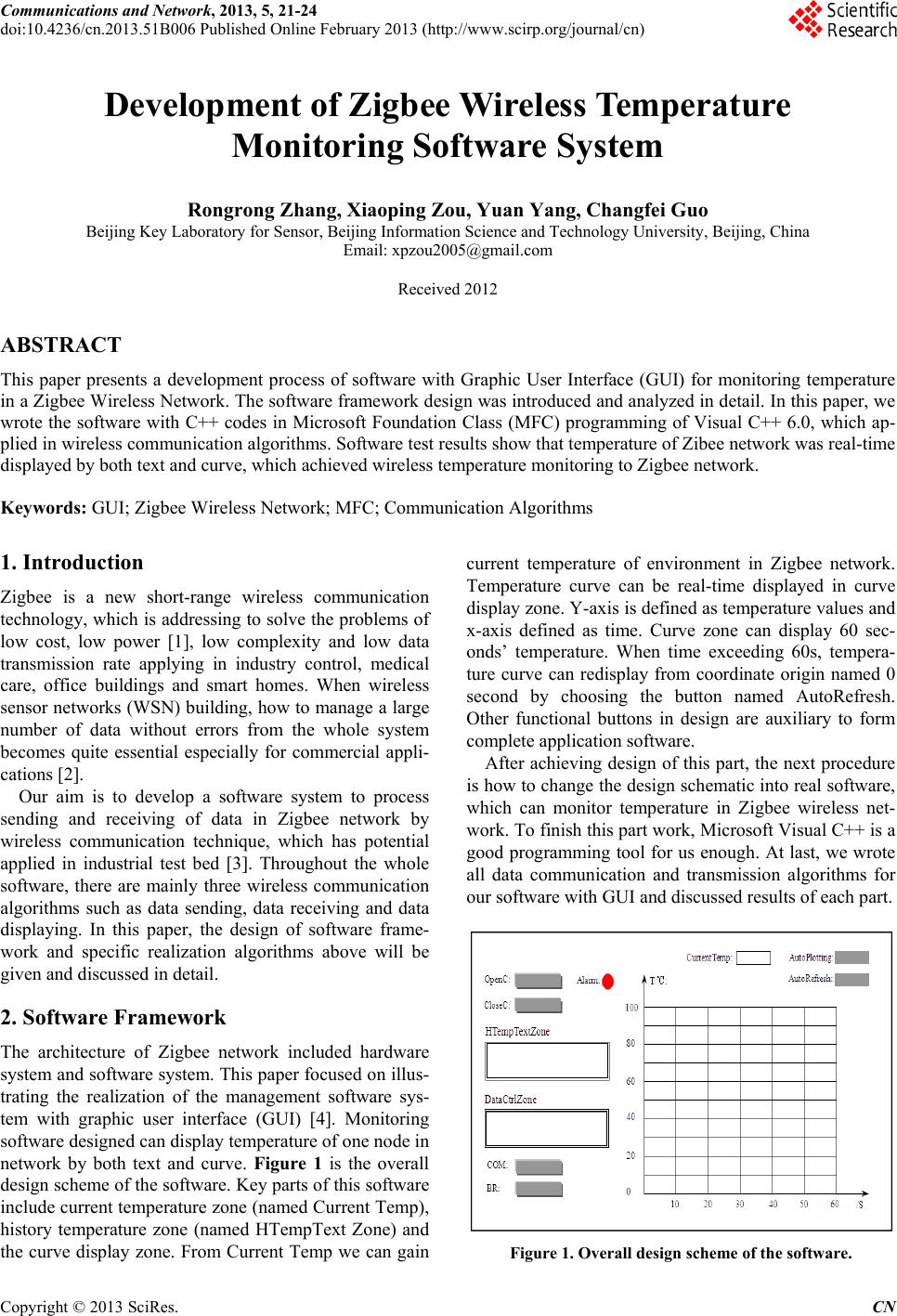
Communications and Network, 2013, 5, 21-24
doi:10.4236/cn.2013.51B006 Published Online February 2013 (http://www.scirp.org/journal/cn)
Development of Zigbee W ir eless Temperatur e
Monitoring Software System
Rongrong Zhang, Xiaoping Zou, Yuan Yang, Changfei Guo
Beijing Key Laboratory for Sensor, Beijing Information Science and Technology University, Beijing, China
Email: xpzou2005@gmail.com
Received 2012
ABSTRACT
This paper presents a development process of software with Graphic User Interface (GUI) for monitoring temperature
in a Zigbee Wireless Network. The software framework design was introduced and analyzed in detail. In this paper, we
wrote the software with C++ codes in Microsoft Foundation Class (MFC) programming of Visual C++ 6.0, which ap-
plied in wireless communication algorithms. Software test results show that temperature of Zibee network was real-time
displayed by both text and curve, which achieved wireless temperature monitoring to Zigbee network.
Keywords: GUI; Zigbee Wireless Network; MFC; Communication Algorithms
1. Introduction
Zigbee is a new short-range wireless communication
technology, which is addressin g to solve the problems of
low cost, low power [1], low complexity and low data
transmission rate applying in industry control, medical
care, office buildings and smart homes. When wireless
sensor networks (WSN) building, how to manage a large
number of data without errors from the whole system
becomes quite essential especially for commercial appli-
cations [2] .
Our aim is to develop a software system to process
sending and receiving of data in Zigbee network by
wireless communication technique, which has potential
applied in industrial test bed [3]. Throughout the whole
software, there are mainly three wireless communication
algorithms such as data sending, data receiving and data
displaying. In this paper, the design of software frame-
work and specific realization algorithms above will be
given and discussed in detail.
2. Software Framework
The architecture of Zigbee network included hardware
system and software system. This paper focused on illus-
trating the realization of the management software sys-
tem with graphic user interface (GUI) [4]. Monitoring
software designed can display temperature of one node in
network by both text and curve. Figure 1 is the overall
design scheme of the software. Key parts of this software
include current temperature zone (named Current Temp),
history temperature zone (named HTempText Zone) and
the curve display zone. From Current Temp we can gain
current temperature of environment in Zigbee network.
Temperature curve can be real-time displayed in curve
display zone. Y-axis is defined as temperature values and
x-axis defined as time. Curve zone can display 60 sec-
onds’ temperature. When time exceeding 60s, tempera-
ture curve can redisplay from coordinate origin named 0
second by choosing the button named AutoRefresh.
Other functional buttons in design are auxiliary to form
complete application software.
After achieving design of this part, the next procedure
is how to change th e design schematic into real software,
which can monitor temperature in Zigbee wireless net-
work. To finish this part work, Microsoft Visual C++ is a
good programming tool for us enough. At last, we wrote
all data communication and transmission algorithms for
our software with GUI and discussed results of each part.
Figure 1. Overall design scheme of the software.
Copyright © 2013 SciRes. CN